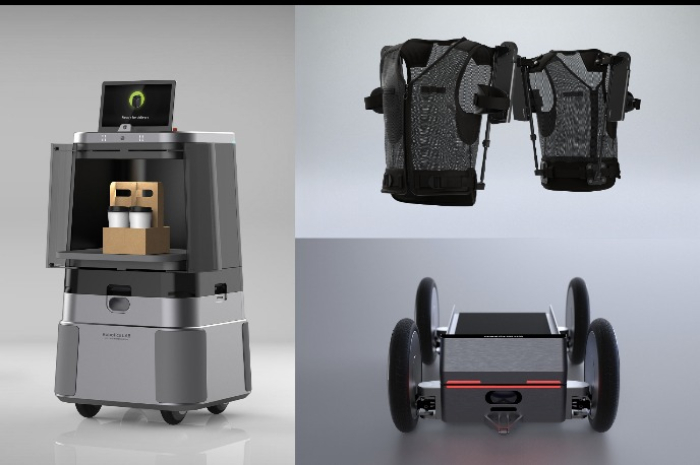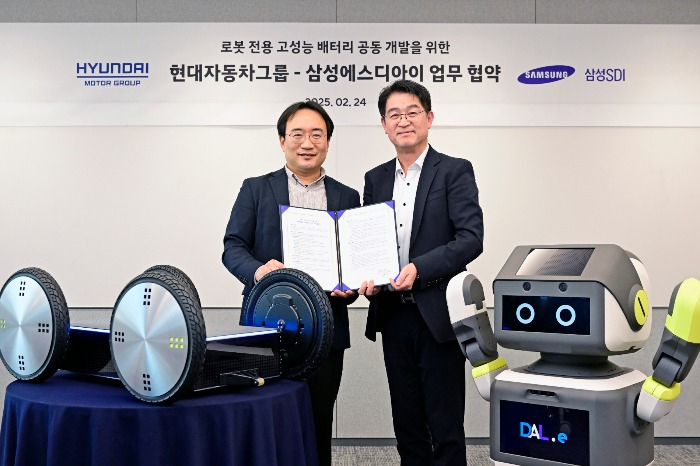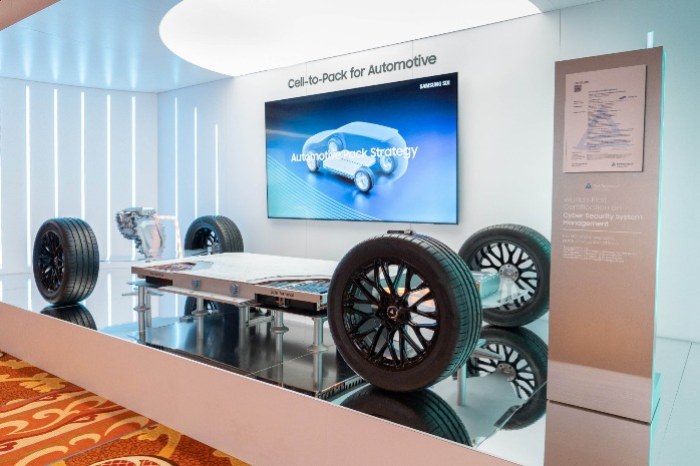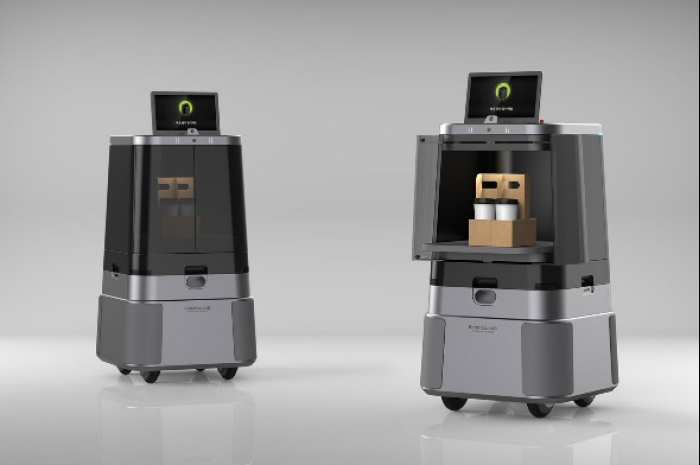Hyundai, Samsung deepen ties to win humanoid race
Samsung SDI will develop solid-state batteries for robots including humanoids, to be developed by Hyundai Motor Group
By Feb 25, 2025 (Gmt+09:00)
LG Chem to sell water filter business to Glenwood PE for $692 million


KT&G eyes overseas M&A after rejecting activist fund's offer


Mirae Asset to be named Korea Post’s core real estate fund operator


StockX in merger talks with Naver’s online reseller Kream


Meritz backs half of ex-manager’s $210 mn hedge fund



South Korea’s household technology and automotive names Samsung and Hyundai have reinforced their alliance to capture the global humanoid robot market set to burgeon to $60 trillion over the next decade.
Hyundai Motor Co., Kia Corp. and Samsung SDI Co. announced on Tuesday that they have agreed to join forces to develop high-performance batteries designed to improve a robot’s energy density, output and operation time.
Under the memorandum of understanding agreement, the world’s sixth-largest battery maker under Samsung Group will develop high-capacity batteries with extended battery usage time for robots.
Hyundai Motor and Kia’s Robotics Lab will evaluate the performance of Samsung’s new batteries by applying them to its robots. Robotics Lab under Hyundai Motor Group develops wearable, service and mobile robots.

Humanoid robots can operate for only one to two hours with the currently available batteries because there are no robot-dedicated batteries, said an official from Samsung SDI.
Humanoids are built to closely resemble human motion and behavior to work alongside humans to improve productivity with everything from folding laundry to handling hazardous waste materials.
“We plan to develop solid-state batteries that can boost robots’ power output and extend their operation hours,” added the official.
HUMANOID BATTERY RACE HAS ALREADY BEGUN
The humanoid robot race is intensifying as the global humanoid market is projected to grow to $60 trillion by 2035, according to Morgan Stanley.
US electric vehicle giant Tesla Inc. plans to use the high-density, cylindrical 4680 battery to be developed by Korea’s battery leader LG Energy Solution Ltd. in its second-generation Optimus humanoid, which will hit the market next year.

China’s UBtech, the country’s first listed humanoid robot company, has also joined hands with its cross-town battery giant BYD to develop humanoid robot-dedicated batteries.
Boston Dynamics' humanoid model, Atlas, is currently powered by a battery with a capacity of 3,700 watt hours (Wh). It can operate for over four hours with simple walking tasks but not even an hour when performing complex tasks requiring AI or lifting heavy loads.
The first-generation Tesla Optimus has a lower capacity of 2,300 Wh, while UBTech robots are equipped with similar-capacity batteries.
Advancements in humanoid performance will require greater battery power as a humanoid robot operates on various advanced technologies like AI, multiple sensors, cameras, drive motors, wireless communication and GPS.
This is why robotics companies and battery manufacturers are rushing to join forces to develop robot-dedicated batteries.
Through the partnership of Hyundai and Samsung, they strive to improve battery energy density by two to three times before the commercialization of humanoids in 2030.
They need to develop smaller but still-powerful batteries for humanoids considering that human-like robots have less space for batteries than cars.

Any company that develops a high-performance battery dedicated to humanoids first will win the humanoid race, said an official from the robotics industry.
SOLID-STATE BATTERY AS A REAL GAME-CHANGER
The so-called 4680 battery, which measures 46 millimeters in diameter and 80 mm in length, is being heralded as a game-changer as it is known to increase energy density by five times and output by six times compared to the conventional 2170 type.
LG Energy Solution and Samsung SDI are set to begin mass production of the 46 series this year.
Tesla’s new Optimus to be powered by LG Energy Solution’s 4680 batteries is expected to operate two to three hours longer than now with an increased energy capacity of a maximum of 8,600 Wh.
Hyundai Motor and Kia are reportedly planning to use Samsung SDI's cylindrical batteries designed for robots to power their service robot DAL-e and delivery robot MobED, while using the 4680 battery in Boston Dynamics’ Atlas.
But robotics companies expect the real game-changer to be the solid-state battery, projected to be developed in the next few years.
The battery is expected to bolster energy capacity to over 20,000 Wh, powerful enough to enable continuous operation of a humanoid robot for up to eight hours, akin to a human worker.
Samsung SDI is leading the charge in developing solid-state batteries, aiming to mass-produce them by 2027.
Its rivals like BYD in China are also ramping up efforts to develop solid-state batteries suitable for humanoids.
Write to Sang Hoon Sung and Hyung-Kyu Kim at uphoon@hankyung.com
Sookyung Seo edited this article.
-
 RoboticsSamsung joins humanoid robots race with larger stake in Rainbow Robotics
RoboticsSamsung joins humanoid robots race with larger stake in Rainbow RoboticsDec 31, 2024 (Gmt+09:00)
3 Min read -
 Future mobilityHyundai-owned Boston Dynamics, Toyota team up for humanoid robots
Future mobilityHyundai-owned Boston Dynamics, Toyota team up for humanoid robotsOct 17, 2024 (Gmt+09:00)
4 Min read -
 BatteriesSamsung, LG go in different directions for all solid batteries
BatteriesSamsung, LG go in different directions for all solid batteriesJul 24, 2024 (Gmt+09:00)
2 Min read -
 BatteriesLG Energy to produce 4680 batteries in August for Tesla, others: CEO
BatteriesLG Energy to produce 4680 batteries in August for Tesla, others: CEOFeb 15, 2024 (Gmt+09:00)
4 Min read -
 BatteriesSamsung SDI inks first battery supply deal with Hyundai
BatteriesSamsung SDI inks first battery supply deal with HyundaiOct 23, 2023 (Gmt+09:00)
1 Min read -
 BatteriesLG Energy to spend $3.1 bn on 4680 battery plant in S.Korea
BatteriesLG Energy to spend $3.1 bn on 4680 battery plant in S.KoreaDec 19, 2022 (Gmt+09:00)
1 Min read -
 RoboticsHyundai-owned Boston Dynamics’ Atlas, Stretch, Spot to take on Tesla Bot
RoboticsHyundai-owned Boston Dynamics’ Atlas, Stretch, Spot to take on Tesla BotNov 23, 2022 (Gmt+09:00)
3 Min read -
 BatteriesSamsung SDI in talks with multiple carmakers for 4680 type battery supply
BatteriesSamsung SDI in talks with multiple carmakers for 4680 type battery supplyJul 29, 2022 (Gmt+09:00)
4 Min read


